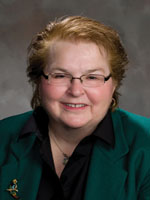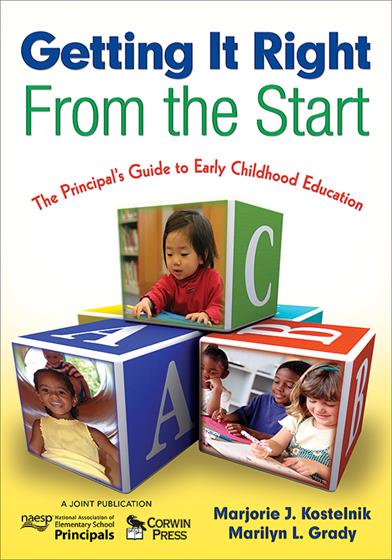
Hands-on, Practical Guidance for Educators
From math,
literacy, equity, multilingual learners, and SEL, to assessment, school counseling,
and education leadership, our books are research-based and authored by experts
on topics most relevant to what educators are facing today.
Getting It Right From the Start
- Grade Level: PreK-K, PreK-12, Elementary
- ISBN: 9781412949507
- Published By: Corwin
- Year: 2009
- Page Count: 344
- Publication date: March 26, 2009
Price: $45.95
For Instructors
When you select 'request review copy', you will be redirected to Sage Publishing (our parent site) to process your request.
Description
"The day of preschool-aged children fully immersed in the public schools will be as common as kindergarten in the very near future. (And in many states, that day is here!) As principals prepare to embrace and successfully guide the addition of preschool children, families, and staff, they will need support and guidance in their new role as an early childhood/elementary principal. This book provides principals with exceptional support, guidance, and action plans to make their transition seamless."
—Ginger L. Zierdt, Director, Center for School-University Partnerships
Minnesota State University, Mankato
"In one relatively small volume, the authors have organized information on just about everything a school leader needs to get a well-designed program off the ground and make sure it will get better as time goes on."
—Harriet A. Egertson, Early Childhood Consultant
Early Childhood Assessment Consortium, Council of Chief State School Officers
"This book is a tremendous resource for principals. As a former elementary principal, I wish I had this book to help me better understand and support the preschool classrooms in my building! Now as an education program evaluator and researcher, I realize how little I knew then about best practices in early childhood. This book will help principals better understand the components of learning through play, intentional design of classroom environments to foster learning, and the value of partnering with families."
—Lisa St. Clair, Nebraska PIRC Director and Assistant Professor of Pediatrics
Munroe-Meyer Institute, University of Nebraska Medical Center
Prepare our youngest students for future learning success with effective ECE programs!
To ensure that young children are ready to enter kindergarten, elementary schools are becoming increasingly involved in early childhood education (ECE), and more and more principals have to deal with ECE issues. Now this practical manual shows principals what successful ECE programs look like—and how to achieve quality results in their schools and communities.
The authors provide an inside view of the field, touching on key areas of operation and discussing ways to avoid common pitfalls. Blending research-based content with practical applications, this accessible guide helps principals and other administrators:
- Gain a foundational understanding of how very young children learn
- Create quality environments and practices for teaching early learners
- Provide the kind of feedback staff need to improve
- Work successfully with ECE agencies and providers
- Easily implement the strategies outlined using reproducible forms, templates, and checklists
This comprehensive resource presents the information principals need to become key players in educating our nation's youngest learners!
Key features
- Blends research-based content with practical implications for administrative practice
- Incorporates numerous easy-to-reference charts and checklists
- Presents a "Principal's Roles" section in each chapter with summaries of key success strategies
- Provides an appendix with additional reproducible tools, including sample forms and rating scales
Author(s)

Marjorie J. Kostelnik

Marilyn L. Grady
Marilyn L. Grady, is professor of educational administration at the University of Nebraska-Lincoln (UNL). She is the author or coauthor of 23 books, including From Difficult Teachers to Dynamic Teamwork (2009) with Brock, Getting it Right from the Start (2009) with Kostelnik From First Year to First Rate (2007) with Brock, 194 High-Impact Letters for Busy Principals (2006), 20 Biggest Mistakes Principals Make and How to Avoid Them (2004) and Launching Your First Principalship (2004) with Brock. Her research areas include leadership, the principalship, and superintendent-board relations. She has more than 175 publications to her credit. She is the editor of the Journal of Women in Educational Leadership. Her editorial board service has included Educational Administration Quarterly, International Studies in Educational Administration, International Journal of Learning, Rural Educator, Journal of At-Risk Issues, Journal of School Leadership, Advancing Women in Leadership On-Line Journal, Journal for Rural School and Community Renewal, International Journal of Learning, and Journal for a Just and Caring Education. She is the recipient of the Stanley Brzezinski Research Award, NCPEA’s Living Legend Award, the Donald R. and Mary Lee Swanson Award for Teaching Excellence, UNL’s Distinguished Teaching Award, and UNL’s Award for Outstanding Contributions to the Status of Women.
Grady coordinates an annual conference on women in educational leadership that attracts national attendance and is in its 24th year. She has been an administrator in K-12 schools as well as at the college and university levels. She received her bachelor’s degree in history from Saint Mary’s College, Notre Dame, Indiana, and her doctorate in educational administration with a specialty in leadership from The Ohio State University.
Table of Contents
Preface
About the Authors
1. Early Childhood Education: An Expanding Enterprise!
Increasing Family Demand
Early Learning Imperatives
Children at Risk of School Failure
Reducing the Achievement Gap: Starting Early
Early Childhood Education: A Sound Investment
Principals’ Roles: Laying the Groundwork
2. Quality Makes ALL the Difference
The Corrosive Impact of Poor Quality
High-Quality Defined
Leadership and High Quality
Becoming an Early Childhood Leader
Principals’ Roles: Achieving High Quality
3. Breaking New Ground: Getting Involved in Early Childhood Education
What Exactly Is Early Childhood Education?
Becoming Familiar With Early Childhood Culture
School Principals as Culture Brokers
Principals’ Roles: Getting Involved in Early Childhood Education
4. Early Childhood Education: Stakeholders
Identifying the Stakeholder
Collaboration
Give Voice to Stakeholders
Actions and Considerations
Principals’ Roles: Working With Stakeholders
5. Developmentally Appropriate Practice
Fundamental Principles of DAP
Developmentally Inappropriate Practice (DIP)
Applying DAP Requires Judgment
The Sounds of DAP!
Empirical Support for DAP
Common Questions About DAP
Principals’ Roles: Supporting DAP
6. The Principal’s Guide to How Young Children Develop and Learn
The Essential Nature of Young Children
How Young Children Develop
How Young Children Learn
What Children Are Learning
Principals’ Roles: Supporting Child Development and Learning
7. Early Childhood Curriculum
What Constitutes the Early Childhood Curriculum?
‘Goodness of Fit’ Between Early Education and Later Schooling
Implementing the Early Childhood Curriculum
Activities to Look for in Early Childhood Classrooms
Principal’s Roles: Curriculum
8. Learning Centers & Classroom Routines
Typical Learning Centers for Young Children
Skills Teachers Need to Run Effective Centers
How Classroom Routines Support Curricular Goals
A Typical Day for Children
Principals’ Roles: Centers and Routines
9. Early Childhood Assessment
Key Considerations
Authentic Assessment
Strategies to Guide Learning and Improve Instruction
Strategies for Identifying Children’s Special Needs
Assessing Early Childhood Programs and Learning Contexts
Pros and Cons of Standardized Assessment
The Principals’ Roles: Promoting Authentic Assessment
10. Early Childhood Education: Family Involvement
Through the Eyes of the Families
Looking Inside and Looking Outside
Suggestions for Families
Through the Eyes of Teachers
Parents Want Communication With the School
Family Roles
Principals’ Roles: Family Involvement
11. Early Childhood Teachers
Teachers Matter
The Critical Function of Principals
Characteristics of ‘Good’ Teachers
Formal Teacher Qualifications
Translating Teacher Standards Into Practice
Principals’ Roles: Supporting Early Childhood Teachers
12. Finding and Keeping Good Teachers
Shortage of Qualified Early Childhood Teachers
Looking for Teachers to Support Diverse Children and Families
Reducing Staff Turnover
Principals’ Roles: Hiring and Retaining Good Teachers
13. Physical Environments That Support Early Learning
Environmental Propositions
How Physical Environments Influence Child Development and Learning
Fundamentals of Environmental Planning
Physical Requirements of Activity-Based Instruction
Equipping Early Childhood Classrooms
The Great Outdoors!
Principals’ Roles: Creating Optimal Early Learning Environments
14. Early Childhood Education: Funding
Funding Sources
History of Federal Funding
State Funding
Local Funding
Start-Up Costs
Administrator Voices
Principals’ Roles: Funding
15. Action Summary
Tool A. Learning Center Checklist
Tool B. Key Instruments Used Nationally for Evaluation of Children in ECE Programs
Tool C. Daily Literacy Checklist P3
Tool D. Daily Numeracy Checklist P3
Tool E. Guidelines for Structuring Informative On-Site Observations
Tool F. Sample Interview Questions for Teacher Candidates
Tool G. Early Childhood Safety & Health Checklist
Tool H. Physical Requirements of Small Group Activity Centers
Tool I. ECE Classroom Equipment List
Tool J. Indoor Environment Checklist
References
Index
Reviews
"In one relatively small volume, the authors have organized information on just about everything a school leader needs to get a well-designed program off the ground and to make sure it will get better as time goes on. A particular strength of the book is its effectiveness in defining the years of preschool through third grade as a cohesive unit within the school. This is especially evident in the extensive chapter on assessment. The book will have value for both current practitioners and those preparing to become elementary administrators."Harriet A. Egertson, Early Childhood Consultant
Early Childhood Assessment Consortium, Council of Chief State School Officers
"The day of preschool-aged children fully immersed in the public schools will be as common as kindergarten in the very near future. (And in many states, that day is here!) As principals prepare to embrace and successfully guide the addition of preschool children, families, and staff, they will need support and guidance in their new role as an early childhood/elementary principal. This book provides principals with exceptional support, guidance, and action plans to make their transition seamless."Ginger L. Zierdt, Director, Center for School-University Partnerships
Minnesota State University, Mankato
“This book is a tremendous resource for principals. As a former elementary principal, I wish I could have had this book in my hands then to help me better understand and support the preschool classrooms in my building! This book will help principals better understand the components of learning through play, intentional design of classroom environments to foster learning, and the value of partnering with families.”Lisa St. Clair, Nebraska PIRC Director and Assistant Professor of Pediatrics
Munroe-Meyer Institute, University of Nebraska Medical Center
"Provides administrators with an easy-to-follow, detailed road map for a better understanding of early childhood education. For some quick information for the meeting, check out the Principal’s Role section. It is a superb resource, while the chapter provides the entire substance of developing the program."Ramona Miller, Principal
Mahnomen Elementary School, MN
"As a former principal, I was informed one year that I would open four 4-year-old classrooms in August of the next year. I understood developmentally appropriate practices and the abiding need to hire terrific early childhood teachers and teaching assistants. What I did not have in my toolbox were the structural components, such as how to create a daily schedule; how and where to provide for students' personal needs (eating, toileting, playing, transporting, etc.); and how to assess student progress and communicate effectively with parents. This guide would have supported my own learning and eased my sense of frustration in not providing adequate leadership for my team. This book offers school leaders a foundational resource of best practices and research that can support an immediate need."Christi Roach, Executive Director
Oklahoma Association of Elementary School Principals
For Instructors
When you select 'request review copy', you will be redirected to Sage Publishing (our parent site) to process your request.

